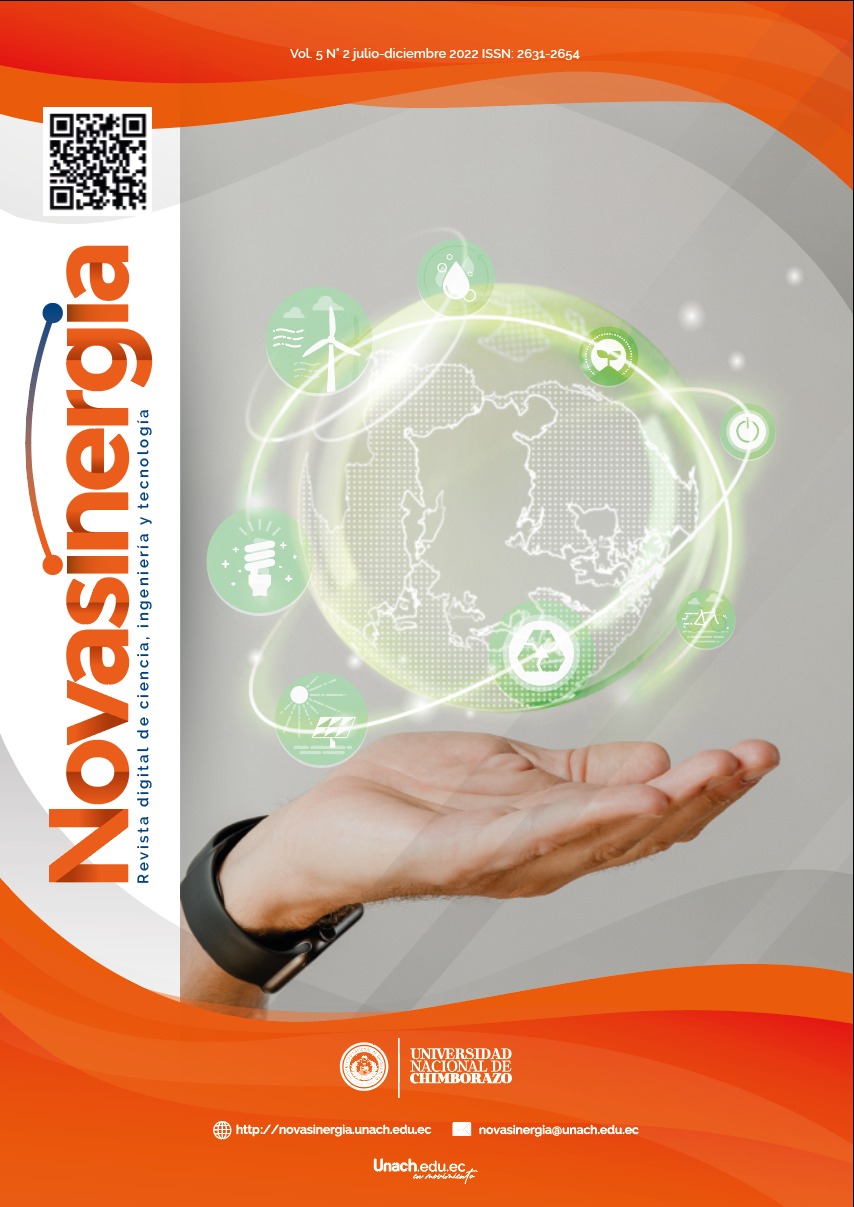Carbon footprint evaluation of vehicles with electric motor and internal combustion engine according to Ecuador energetic matrix: Study case KIA Soul vs KIA Soul EV
DOI:
https://doi.org/10.37135/ns.01.10.04Keywords:
Carbon footprint, electric vehicle, energy matrix, life cycle, well to wheelAbstract
In this work, the results of carbon footprint evaluation of both an internal combustion engine vehicle (ICEV) and battery electric vehicle (BEV), considering the Ecuador energy scene, is presented. For this purpose, Well-to-Wheel analysis was used, firstly determining the electric energy generation matrix of the country. First, the KIA Soul vehicle and KIA Soul EV (electric version) were considered study cases. Then, manufacturers' technical characteristics were used to determine each vehicular technology's carbon footprint and considerations such as util life-route driving, fuel path, util life-time and replacement of batteries, and emissions due to chassis and body vehicle. Obtained results allowed for determining that greenhouse gas emissions in Ecuador due to the ICEV is 236.16 gCO2/km. On the other hand, the BEV emitted 63.14 gCO2/km, significantly barely 27% of emissions. These results represent a positive impact on reducing ambient contamination indices and reinforce the necessity for accelerating the change in the country's energy matrix toward a cleaner and more sustainable energy generation.
Downloads
References
ARCERNNR. (2021). Estadística Anual y Multianual del Sector Eléctrico Ecuatoriano 2020. Quito - Ecuador. Recuperado de https://www.controlrecursosyenergia.gob.ec/wp-content/plugins/download-monitor/download.php?id=1855&force=1
Bhandari, R., Kumar, B., & Mayer, F. (2020). Life cycle greenhouse gas emission from wind farms in reference to turbine sizes and capacity factors. Journal of Cleaner Production, 277, 123385. https://doi.org/10.1016/j.jclepro.2020.123385
Briones-Hidrovo, A., Uche, J., & Martínez-Gracia, A. (2017). Accounting for GEI net reservoir emissions of hydropower in Ecuador. Renewable Energy, 112, 209–221. https://doi.org/10.1016/j.renene.2017.05.047
Cai, H., Brandt, A. R., Yeh, S., Englander, J. G., Han, J., Elgowainy, A., & Wang, M. Q. (2015). Well-to-Wheels Greenhouse Gas Emissions of Canadian Oil Sands Products: Implications for U.S. Petroleum Fuels. Environmental Science and Technology, 49(13), 8219–8227. https://doi.org/10.1021/acs.est.5b01255
Chau, K. T. (2014). 21 - Pure electric vehicles. Alternative Fuels and Advanced Vehicle Technologies for Improved Environmental Performance: Towards Zero Carbon Transportation, 655–684. https://doi.org/10.1533/9780857097422.3.655
Choi, W., & Song, H. H. (2014). Well-to-wheel analysis on greenhouse gas emission and energy use with natural gas in Korea. International Journal of Life Cycle Assessment, 19(4), 850–860. https://doi.org/10.1007/s11367-014-0704-7
Córdova-Suárez, M., Carrasco, M., Padilla, P., & Garcés-Sánchez, E. (2018). Estudio de la Huella de Carbono en Unidades Desconcentradas de Terminales Terrestres. Revista Politécnica, 41(1), 39–44. Recuperado de http://scielo.senescyt.gob.ec/pdf/rpolit/v41n1/2477-8990-rpolit-41-01-00039.pdf
Córdova, M., Cordova, D., Alvarez, F. C., Chaglla, M. T., Pico, P. E., & Pérez, L. V. (2018). Carbon Footprints in Ecuador: Case of Riobamba city’s Bus Stations. IOP Conference Series: Earth and Environmental Science, 151, 012001. Retrieved from https://iopscience.iop.org/article/10.1088/1755-1315/151/1/012001/pdf
Fontaras, G., Zacharof, N.-G., & Ciuffo, B. (2017). Fuel consumption and CO 2 emissions from passenger cars in Europe – Laboratory versus real-world emissions. Progress in Energy and Combustion Science, 60, 97–131. https://doi.org/10.1016/j.pecs.2016.12.004
Garcia-Pinargote, D. F., Benítez-Sornoza, G. J., Vásquez-Pérez, A., & Rodríguez-Gámez, M. (2021). La generación distribuida y su regulación en el Ecuador. Brazilian Journal of Business, 3(3), 2018–2031. https://doi.org/10.34140/bjbv3n3-001
Hall, D., & Lutsey, N. (2018). Effects of battery manufacturing on electric vehicle life-cycle greenhouse gas emissions. ICCT Briefing. International Council on Clean Transportation. Recuperado de: https://theicct.org/wp-content/uploads/2021/06/EV-life-cycle-GHG_ICCT-Briefing_09022018_vF.pdf
HINICIO. (2020). Informe de evaluación de ciclo de vida de los vehículos hidrógeno eléctricos (hidrógeno y a batería). Recuperado de: https://h2lac.org/portfolio-items/creacion-de-condiciones-del-ecosistema-del-hidrogeno-en-aplicaciones-de-movilidad-electrica-en-costa-rica/
Iannelli, L., Gil, S., & Prieto, R. (2018). Vehículos Híbridos a Gas (GNC). Energías Renovables y Medio Ambiente, 41, 27–37. Recuperado de: http://portalderevistas.unsa.edu.ar/ojs/index.php/erma/article/viewFile/1013/975
Isla-Martínez, P. (2017). Estudio comparativo de la huella de carbono de motores de encendido provocado alimentados con gasolina y bioetanol (Trabajo final de grado). Madrid: España. Universidad Politécnica de Madrid. Recuperado de: https://oa.upm.es/45573/1/TFG_PATRICIA_ISLA_MARTINEZ.pdf
Jang, J. J., & Song, H. H. (2015). Well-to-wheel analysis on greenhouse gas emission and energy use with petroleum-based fuels in Korea: gasoline and diesel. International Journal of Life Cycle Assessment, 20. 1102-1116. https://doi.org/10.1007/s11367-015-0911-x
KIA Motors. (n.d.-a). Ficha Técnica - KIA Soul EV. Recuperado de: KIA Motors: https://www.marcali.com/kia-producto/images/carros/218/Kia-KIA-SOUL-EV.pdf
KIA Motors. (n.d.-b). Webpage: KIA Soul. Recuperado de: https://www.kia.com/ec/showroom/nuevo-soul/features.html
KIA Motors. (n.d.-c). Webpage: KIA Soul EV. Recuperado de: https://www.kia.com/ec/showroom/soul-ev.html
Km77. (n.d.-a). Webpage: KIA Soul Concept 1.6 GDi 132 CV Eco-Dynamics (2014-2016) | Precio y ficha técnica. Recuperado de: https://www.km77.com/coches/kia/soul/2014/estandar/concept/soul-2014/datos
Km77. (n.d.-b). Webpage: KIA Soul Eléctrico (2014-2017) | Precio y ficha técnica. Recuperado de: https://www.km77.com/coches/kia/soul/2014/estandar/electrico/soul-ev/datos
Kumar, L., & Jain, S. (2014). Electric propulsion system for electric vehicular technology: A review. Renewable and Sustainable Energy Reviews, 29, 924–940. https://doi.org/10.1016/j.rser.2013.09.014
Kuo, G. (2019). When Fossil Fuels Run Out, What Then? - MAHB. Recuperado de: https://mahb.stanford.edu/library-item/fossil-fuels-run/
Leach, F., Kalghatgi, G., Stone, R., & Miles, P. (2020). The scope for improving the efficiency and environmental impact of internal combustion engines. Transportation Engineering, 1. https://doi.org/10.1016/j.treng.2020.100005
Martinez, I. (n.d.). Fuel Properties. Retrieved from Madrid, España: http://webserver.dmt.upm.es/~isidoro/bk3/c15/Fuel properties.pdf
Messagie, M. (2015). Life Cycle Analysis of the Climate Impact of Electric Vehicles. Recuperado de: https://www.transportenvironment.org/wp-content/uploads/2021/07/TE%20-%20draft%20report%20v04.pdf
Moro, A., & Helmers, E. (2017). A new hybrid method for reducing the gap between WTW and LCA in the carbon footprint assessment of electric vehicles. International Journal of Life Cycle Assessment. 22. 4-14. https://doi.org/10.1007/s11367-015-0954-z
NREL-U.S. (2012). Life Cycle Greenhouse Gas Emissions from Solar Photovoltaics. Renewable and Sustainable Energy Reviews. Recuperado de: https://www.nrel.gov/docs/fy13osti/56487.pdf
Ozdemir, A., Koc, I. M., & Sumer, B. (2020). Comparative study on Well-to-Wheels emissions between fully electric and conventional automobiles in Istanbul. Transportation Research Part D: Transport and Environment, 87, 102508. https://doi.org/10.1016/j.trd.2020.102508
Parra-Narváez, R. (2015). Factor de emisión de CO2 debido a la generación de electricidad en el Ecuador durante el periodo 2001-2014. ACI Avances en Ciencias e Ingenierías, 7(2), 2–5. https://doi.org/10.18272/aci.v7i2.269
Pérez-Martínez, P. J., Miranda, R. M., Andrade, M. F., & Kumar, P. (2020). Air quality and fossil fuel driven transportation in the Metropolitan Area of Sao Paulo. Transportation Research Interdisciplinary Perspectives, 5. https://doi.org/10.1016/j.trip.2020.100137
Prado-Carpio, E., & Castro-Armijos, C. J. (2017). Energy Intensity of Ecuador and Estimate of Carbon Footprint. Revista Universidad Y Sociedad, 9(2), 232–236. Recuperado de: http://scielo.sld.cu/pdf/rus/v9n2/rus31217.pdf
Reich, N. H., Alsema, E. A., van Sark, W. G. J. H. M., & Nieuwlaar, E. (2007). CO2 Emissions of PV in the perspective of a Renewable Energy Economy. 22nd European Photovoltaic Solar Energy Conference and Exhibition, (September), 3538–542. Recuperado de: https://dspace.library.uu.nl/bitstream/handle/1874/27301/NWS-E-2007-150.pdf?sequence=1&isAllowed=y
Román-Collado, R., Sanz-Díaz, M. T., & Loja-Pacheco, C. (2021). Towards the decarbonisation of Ecuador: a multisectoral and multiregional analysis of its carbon footprint. Environmental Science and Pollution Research, 28(38), 53412–53431. https://doi.org/10.1007/s11356-021-14521-1
Shen, W., Han, W., & Wallington, T. J. (2014). Current and future greenhouse gas emissions associated with electricity generation in China: Implications for electric vehicles. Environmental Science and Technology, 48(12), 7069–7075. https://doi.org/10.1021/es500524e
Tuza-Chamorro, D. D. (2021). Análisis del sector eléctrico ecuatoriano: Estado actual y perspectivas (Trabajo de grado previo a la obtención del título de Ingeniero en Mantenimiento Eléctrico). Ibarra:Ecuador. Universidad Técnica del Norte. Recuperado de: http://repositorio.utn.edu.ec/handle/123456789/11566
Vera, J. F., Clairand, J. M., & Bel, C. Á. (2017). Public policies proposals for the deployment of electric vehicles in Ecuador. In 2017 IEEE PES Innovative Smart Grid Technologies Conference - Latin America, ISGT Latin America 2017 (Vol. 2017-Janua, pp. 1–6). https://doi.org/10.1109/ISGT-LA.2017.8126718







